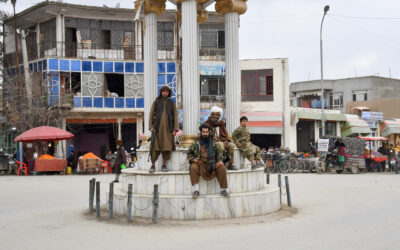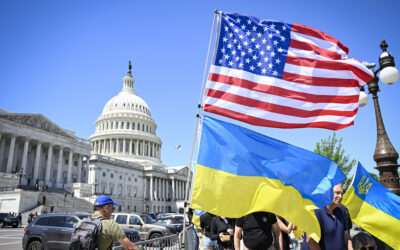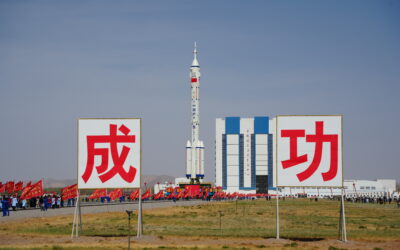
The Long Arm of China’s Security Services
SUBSCRIBER+ EXCLUSIVE REPORTING — When Chinese President Xi Jinping came to San Francisco last November to meet with President Joe Biden, Chinese pro-democracy activists in […] More
Pulitzer Prize Winning Journalist Walter Pincus is a contributing senior national security columnist at The Cipher Brief. Pincus spent forty years at The Washington Post, writing on topics from nuclear weapons to politics. He is the author of Blown to Hell: America’s Deadly Betrayal of the Marshall Islanders (releasing November 2021)
OPINION — “Right now, we can hold any target on the planet at risk today. We do. And we do that every day, and everybody knows it. That’s the nuclear weapons that are deployed every day. The adversaries that we face cannot do anything about those nuclear weapons and so that holds everything at risk.”
That’s Vice Chairman of the Joint Chiefs of Staff Gen. John Hyten, speaking late, in an hour-long interview eight days ago, with the Brookings Institution’s specialist in defense strategy, Michael O’Hanlon. Hyten, a former head of Strategic Command (STRATCOM) who is set to retire soon, followed up with the downside of the U.S. position saying, “But if your only ability to hold a target at risk is a nuclear weapon, that is a bad place to be. That is a really bad place to be because that runs the risk of an escalation in a war that we don’t want to risk.”
Hyten then shared an anecdote, saying that as STRATCOM Commander, after he first briefed now-Joint Chiefs Chairman Gen. Mark Milley for an hour on the complexities of the U.S. strategic nuclear weapons program, Milley asked for an explanation “in simple English. ‘Why do we have nuclear weapons?’ My answer,” Hyten said, “was one sentence – to keep people from using nuclear weapons on us.”
Right there, he expressed what I believe is the nuclear weapons dilemma – they may be unusable – but nonetheless, the U.S. has programs underway to keep the current force for another 40 years. A reminder: The U.S. has some 1,400 or so nuclear warheads currently deployed. The U.S. Government has been spending hundreds of billions updating warheads, thinking of new ones, and is already on the way to replacing all three delivery systems of the nuclear Triad – new strategic submarines, strategic bombers and ground-based Intercontinental Ballistic Missiles (ICBMs).
Hyten last week, also had this answer to the nuclear weapons dilemma. “You don’t want your only capability to be the capability that would cause an escalation into nuclear conflict,” he said, “that’s why we need hypersonic capabilities.”
Yes, the U.S. must continue to upgrade its nuclear weapons, the delivery systems and the nationwide weapons building complex that keeps it all going, but at the same time, Hyten said, “The real requirement is conventional prompt strike – that’s the real requirement [to] conventionally hold targets at risk anywhere. Hypersonics happen to be one of the solutions to do that. But cruise missiles can do that. Other capabilities can do that as well. We need a mix of capabilities to do that.”
So, the future, as Hyten sees it, is that the U.S. needs to be able to promptly strike targets worldwide, not just with nuclear weapons but with conventional weapons as well.
Here, I have to point out that earlier in the interview, O’Hanlon asked Hyten about the likelihood of war with China, which the Vice Chief said was now, “the pacing threat that we have to be concerned about, not only today but in the near-term and in the long-term.”
O’Hanlon cited “Thucydides Trap,” the notion he said that, “most times when you have a new superpower [China] arise to the level of an old one [the U.S.], war is the vehicle or method by which they adjudicate their relative standing.”
Hyten looked back at the Cold War and said, “We went through what was the most significant, you know, confrontation between two great powers that the world had seen at that time because it was the first two great powers that had massive nuclear weapons. And we never came to major war during that entire period. We didn’t because we always maintained a deterrent, they always maintained a strategic deterrent. And because of that we never crossed the line. It doesn’t mean that there weren’t conflicts… But fundamentally, we never went to war with the Soviet Union.”
Hyten then shared what he thought was the lesson from that Cold War experience.
“So, when you look at great powers,” he said, “our goal should be to never go to war with China, to never go to war with Russia, because that day is a horrible day for the planet, a horrible day for our countries. It wrecks the world; it wrecks the world’s economy. It’s bad for everybody. So, we have to make sure we don’t go down that path.”
However, eight minutes later, Hyten said, “The specific capabilities that worry me about China are not the capabilities about the future of Taiwan, it’s the almost unprecedented (Chinese) nuclear modernization that is now becoming public.”
The Cipher Brief hosts private briefings with the world’s most experienced national and global security experts. Become a member today.
Remember, for years, China has practiced what it calls “minimum deterrence,” with the Pentagon saying last year that as of the end of 2019, “The number of warheads on the PRC’s (People’s Republic of China) land-based ICBMs capable of threatening the United States is expected to grow roughly 200 in the next five years.” Now, Hyten said, “It seems like every couple of weeks new pictures of more silos (in China) were coming in. And, oh, by the way, there’s no limits on what China can put in those silos. So, we’re limited [by treaty] with Russia to 1,550 deployed nuclear weapons. So, we have to decide where we want to put those –– submarines, ICBMs. Bombers are counted a little bit differently under that treaty, but that puts a limit on what we have. China, there’s no limit. They could put, you know, 10 re-entry vehicles on every one of those ICBMs if they wanted to. There’s nothing to limit that ability.”
Hyten then continued, “So the speed and difference in that threat is what really concerns me most…You have to ask yourself, why are they building that enormous, enormous nuclear capability faster than anybody in the world. That’s what really concerns me.”
I question Hyten’s enormous concern about China’s nuclear program. True, China is engaged in a major nuclear buildup that includes moving toward a Triad of nuclear delivery systems – but that is something the U.S. has had for almost 50 years. And, as pointed out above, the U.S. is modernizing its nuclear force to last another 40 years.
Beijing’s construction of missile silos, which may top 400, doesn’t mean each will contain an ICBM. The U.S., by the way, has 450 ICBM silos, 400 of which hold ICBMs, while missiles for the empty ones are in storage. Didn’t Hyten just say that the fact that the U.S. and Russia had comparable numbers of nuclear weapons meant they have since “never crossed the line” and had avoided direct military confrontations?
I lived through the Cuban missile crisis of 1963, working at the time for Sen. J.W. Fulbright (D-Ark.), then-chairman of the Senate Foreign Relations Committee. In October 1963, there was real fear of the possible use of Russian and American nuclear weapons. Years after that crisis was over, I talked to then-retired Defense Secretary Robert McNamara about it. McNamara said he had explained to then-President Kennedy during a meeting one night that no one knew what would happen if one nuclear weapon was used and an exchange of those weapons followed.
From that day on, the U.S. and Soviet Union (now Russia) have avoided any similar, direct military conflict and have also opened a hot line for presidents and military leaders to talk directly with each other at times of crisis. A lesson had been learned.
Go beyond the headlines with expert perspectives on today’s news with The Cipher Brief’s Daily Open-Source Podcast. Listen here or wherever you listen to podcasts.
Hyten said at Brookings, “We’re having strategic stability talks with Russia to make sure we understand where they are, not just in the nuclear realm but in space as well. We need to have that conversation start as well with the Chinese. We really do…As different as we are, we do have a fundamental common goal and that is to never go to war with each other because war with a nuclear power is a bad thing.”
Having written about nuclear weapons for more than 50 years, I have come to believe there has never been any serious logic attached to using them in warfare since Hiroshima and Nagasaki. Those first atomic bombs were built in the 1940s to be terror weapons to end a war, and just two of them did that, with destructive power much less than the thousands of thermonuclear warheads we and our adversaries have today.
I believe, as Hyten implied, they have become unusable weapons, but they have since prevented nuclear powers that posses them from going to full-scale, open warfare against each other.
The new question may be, are we now in a new arms race with strategic conventional weapons like hypersonics? More to come on that.
Read more expert-driven national security insights, perspective and analysis in The Cipher Brief
Related Articles

SUBSCRIBER+ EXCLUSIVE REPORTING — When Chinese President Xi Jinping came to San Francisco last November to meet with President Joe Biden, Chinese pro-democracy activists in […] More

SUBSCRIBER+EXCLUSIVE EXPERT PERSPECTIVE — More than two years after its withdrawal from Afghanistan, the U.S. still does not have a clear way forward in the […] More

SUBSCRIBER+ EXCLUSIVE REPORTING — Ukrainians greeted Saturday’s long-awaited House passage of $60.8 billion in aid with justifiable jubilation. For months, their soldiers, civilians, and political […] More

SUBSCRIBER+ EXCLUSIVE REPORTING — A race for control of space is underway, and just as on earth, the U.S. and China are the top competitors. […] More

SUBSCRIBER+ EXCLUSIVE REPORTING — For nearly a week, the Middle East and much of the world were on a knife’s edge, waiting for a promised […] More

BOTTOM LINE UP FRONT – Less than one week after Iran’s attack against Israel, Israel struck Iran early on Friday, hitting a military air base […] More
Search